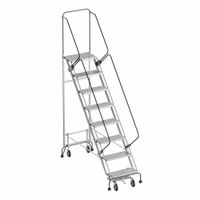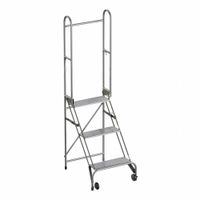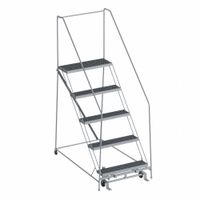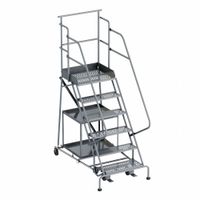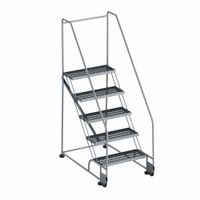Call +(254) 703 030 000 / 751 483 999 / 721 704 777
- Home
- Material Handling
- Ladders Platforms Personnel Lifts
- Ladders
- Rolling Ladders
.....Read More
Frequently Asked Questions
What are rolling ladders used for?
Rolling ladders are mobile ladders equipped with wheels or casters, designed to provide safe and convenient access to elevated areas. They are commonly used in various settings, including warehouses, libraries, retail stores, manufacturing facilities, and distribution centers. The primary purpose of rolling ladders is to facilitate the retrieval, storage, and organization of items located on high shelves or racks, thereby enhancing operational efficiency and safety.
In warehouses and distribution centers, rolling ladders enable workers to access inventory stored at different heights, reducing the need for forklifts or other heavy equipment. This not only speeds up the picking and stocking processes but also minimizes the risk of accidents associated with climbing on unstable surfaces.
In retail environments, rolling ladders allow staff to efficiently manage stock on high shelves, ensuring that products are readily available for customers. This is particularly useful in large stores with vertical storage systems, where space optimization is crucial.
Libraries utilize rolling ladders to access books and materials on high shelves, ensuring that librarians and patrons can safely reach items without the risk of falls. The mobility of these ladders allows for easy repositioning, accommodating the dynamic needs of library spaces.
In manufacturing settings, rolling ladders are used to access machinery, equipment, or storage areas that are elevated, facilitating maintenance, repairs, and inspections. This enhances productivity by allowing workers to perform tasks at height without delay.
Overall, rolling ladders are essential tools for improving accessibility, safety, and efficiency in environments where vertical space is utilized. Their design, which often includes handrails and locking mechanisms, ensures stability and security during use, making them a preferred choice for tasks that require frequent movement and access to elevated areas.
How do rolling ladders with casters work?
Rolling ladders with casters are designed to provide mobility and stability for accessing high shelves or storage areas. They consist of a ladder frame, steps, handrails, and a set of casters. The casters are typically swivel wheels that allow the ladder to be easily moved across the floor.
When not in use, the ladder rests on the casters, allowing it to be pushed or pulled to the desired location. The casters are often equipped with a locking mechanism or a spring-loaded mechanism that engages when weight is applied to the ladder. This mechanism ensures that the ladder remains stationary and stable while in use, preventing it from rolling away.
The ladder frame is usually made of durable materials like steel or aluminum, providing strength and support. The steps are often designed with non-slip surfaces to enhance safety. Handrails are included to offer additional support and balance for the user.
To use the ladder, the user rolls it to the desired location, ensuring the casters are locked or the spring mechanism is engaged. The user then climbs the ladder, using the handrails for support. Once the task is completed, the user descends, disengages the locking mechanism, and rolls the ladder to its storage location.
Overall, rolling ladders with casters combine mobility with safety features, making them ideal for environments like warehouses, libraries, and retail stores where frequent access to elevated areas is required.
What are the different types of rolling ladders?
1. **Tilt and Roll Ladders**: These ladders have wheels on one end, allowing them to be tilted and rolled to different locations. They are ideal for light-duty tasks and are easy to maneuver in tight spaces.
2. **Spring-Loaded Caster Ladders**: Equipped with casters that retract when weight is applied, these ladders provide stability during use. They are commonly used in warehouses and retail environments.
3. **Steel Rolling Ladders**: Made from durable steel, these ladders are designed for heavy-duty use. They are often used in industrial settings where strength and durability are essential.
4. **Aluminum Rolling Ladders**: Lighter than steel, aluminum ladders are corrosion-resistant and easy to move. They are suitable for environments where portability and resistance to rust are important.
5. **Folding Rolling Ladders**: These ladders can be folded for easy storage and transport. They are ideal for locations with limited space and are often used in maintenance and repair tasks.
6. **Cantilever Rolling Ladders**: Featuring an extended platform, these ladders allow users to reach over obstacles. They are useful in situations where direct access is obstructed.
7. **Crossover Ladders**: Designed to allow users to safely cross over obstacles like conveyor belts or machinery, these ladders have platforms and handrails for added safety.
8. **Platform Rolling Ladders**: With a large standing platform, these ladders provide a stable work area. They are often used for tasks that require extended periods of standing.
9. **Warehouse Rolling Ladders**: Specifically designed for warehouse use, these ladders are sturdy and often feature handrails and large steps for safety and ease of use.
10. **Custom Rolling Ladders**: Tailored to specific needs, these ladders can be designed with unique features or dimensions to suit particular applications.
How do you choose the right rolling ladder for a facility?
To choose the right rolling ladder for a facility, consider the following factors:
1. **Height Requirements**: Determine the maximum height you need to reach. Measure the height of the shelves or areas where the ladder will be used to ensure the ladder can safely reach.
2. **Weight Capacity**: Assess the maximum load the ladder needs to support, including the weight of the user and any tools or materials they will carry.
3. **Material**: Choose between aluminum, steel, or fiberglass. Aluminum is lightweight and corrosion-resistant, steel is durable and sturdy, and fiberglass is non-conductive, ideal for electrical environments.
4. **Step Type and Tread**: Decide on the type of steps (e.g., perforated, serrated) based on the level of grip and slip resistance needed. Consider the tread depth for comfort and safety.
5. **Mobility and Maneuverability**: Evaluate the wheel or caster system for ease of movement. Ensure the ladder can be easily moved and locked in place for stability.
6. **Space and Storage**: Consider the available space for using and storing the ladder. Ensure it fits through doorways and aisles and can be stored without obstructing operations.
7. **Safety Features**: Look for features like handrails, guardrails, and locking mechanisms to enhance safety during use.
8. **Compliance and Standards**: Ensure the ladder meets relevant safety standards and regulations, such as OSHA or ANSI, for workplace safety compliance.
9. **Environment**: Consider the environment where the ladder will be used, such as indoor or outdoor, and any specific conditions like moisture or chemicals that may affect the ladder's material.
10. **Budget**: Balance the cost with the features and durability required for your specific needs, ensuring long-term value and safety.
What safety features do rolling ladders have?
Rolling ladders are equipped with several safety features to ensure user safety and stability during use. These features include:
1. **Locking Mechanism**: Rolling ladders often have a locking mechanism that secures the ladder in place when in use, preventing unwanted movement.
2. **Non-Slip Steps**: The steps are typically designed with non-slip surfaces to provide secure footing and reduce the risk of slipping.
3. **Handrails**: Handrails are provided on both sides of the ladder to offer additional support and balance for users as they ascend or descend.
4. **Guardrails**: At the top platform, guardrails are installed to prevent falls and provide a secure area for users to work from.
5. **Sturdy Construction**: Made from durable materials like steel or aluminum, rolling ladders are designed to support significant weight and withstand regular use.
6. **Brakes or Caster Locks**: The wheels or casters often have brakes or locks to keep the ladder stationary when in use, enhancing stability.
7. **Wide Base**: A wide base design increases stability and reduces the risk of tipping over.
8. **Weight Capacity**: Clearly marked weight limits ensure users do not exceed the ladder's safe load capacity.
9. **Tilt-and-Roll Design**: Some ladders have a tilt-and-roll feature that allows easy movement when tilted but remains stable when upright.
10. **Step Depth and Width**: Steps are designed with adequate depth and width to provide a comfortable and secure footing.
11. **Safety Labels and Instructions**: Clear safety labels and usage instructions are often provided to guide users in safe operation.
These features collectively enhance the safety and functionality of rolling ladders, making them suitable for various industrial and commercial applications.
How do you maintain and inspect rolling ladders?
To maintain and inspect rolling ladders, follow these steps:
1. **Regular Inspection**: Conduct visual inspections before each use. Check for any visible damage, such as cracks, bends, or rust on the frame and steps.
2. **Check Wheels and Casters**: Ensure that wheels and casters are in good condition, rotate smoothly, and lock securely. Replace any worn or damaged wheels.
3. **Examine Steps and Treads**: Inspect steps for wear and tear. Ensure that treads are non-slip and securely attached. Replace any damaged or worn treads.
4. **Inspect Handrails and Guardrails**: Ensure that handrails and guardrails are secure and free from damage. Tighten any loose bolts or screws.
5. **Test Stability**: Ensure the ladder is stable when in use. Check that the locking mechanism engages properly to prevent movement during use.
6. **Lubricate Moving Parts**: Apply lubricant to moving parts, such as hinges and wheels, to ensure smooth operation and prevent rust.
7. **Check Weight Capacity**: Verify that the ladder is not overloaded. Adhere to the manufacturer's weight capacity guidelines.
8. **Clean Regularly**: Keep the ladder clean from dirt, grease, and debris to prevent slipping and ensure longevity.
9. **Store Properly**: Store the ladder in a dry, safe place when not in use to prevent damage from environmental factors.
10. **Follow Manufacturer’s Guidelines**: Adhere to the maintenance and inspection guidelines provided by the manufacturer for specific instructions and safety standards.
11. **Record Keeping**: Maintain a log of inspections and maintenance activities for accountability and future reference.
By following these steps, you can ensure the safety, functionality, and longevity of rolling ladders.
What are the benefits of using rolling ladders in warehouses and industrial settings?
Rolling ladders offer several benefits in warehouses and industrial settings:
1. **Mobility**: Equipped with wheels, rolling ladders can be easily moved to different locations, enhancing operational efficiency by allowing workers to access various areas without the need for multiple ladders.
2. **Safety**: Designed with handrails and non-slip steps, rolling ladders provide a stable and secure platform for workers, reducing the risk of falls and injuries compared to traditional ladders.
3. **Versatility**: Available in various heights and configurations, rolling ladders can be used for a wide range of tasks, from accessing high shelves to performing maintenance work, making them suitable for diverse industrial applications.
4. **Space Efficiency**: Rolling ladders can be stored compactly when not in use, saving valuable floor space in crowded warehouse environments.
5. **Load Capacity**: Built to support heavier weights, rolling ladders can accommodate both workers and their tools or materials, facilitating more efficient task completion.
6. **Durability**: Constructed from robust materials like steel or aluminum, rolling ladders are designed to withstand the rigors of industrial use, ensuring long-term reliability and cost-effectiveness.
7. **Ergonomics**: The design of rolling ladders often includes features that reduce strain on workers, such as wider steps and comfortable handrails, promoting better ergonomics and reducing fatigue.
8. **Compliance**: Many rolling ladders meet industry safety standards and regulations, helping businesses maintain compliance with occupational safety requirements.
9. **Increased Productivity**: By providing quick and easy access to elevated areas, rolling ladders help streamline operations, allowing workers to complete tasks more quickly and efficiently.
10. **Flexibility**: Some models offer adjustable heights or additional features like tool trays, further enhancing their utility in various tasks and settings.
